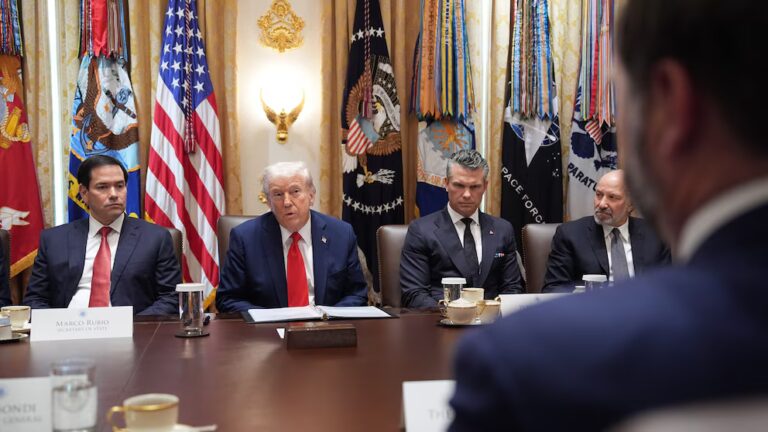
Here, in short, is President Donald Trump’s new plan to combat the opioid epidemic: more punishment, fewer prescriptions, and more treatment.
On Monday, Trump unveiled a new batch of policies for tackling the opioid epidemic in a speech in New Hampshire, one of the states hit hardest by the crisis. The plan is the most comprehensive agenda that the president has detailed since his administration declared the epidemic a public health emergency in 2017. But to the chagrin of many drug policy and public health experts, the plan largely focuses on “tough on crime” efforts that have proven ineffective in the past.
The plan can be broken down into three parts. A slew of law enforcement–focused policies aim to increase penalties for drug dealing and trafficking, including mandatory minimums and, in some cases, the death penalty. The White House is also taking steps to cut back on opioid prescriptions, hoping to reduce them by as much as one-third over three years. And there are some vague promises on increasing access to addiction treatment and adopting harm reduction approaches.
There’s a lot of uncertainty here. Will Congress approve some of the actions that the White House is calling for? Is more money coming to fund the proposals? Will federal prosecutors actually try to make greater use of the death penalty?
The opioid epidemic is now the deadliest drug overdose crisis in US history. Nearly 64,000 people died of drug overdoses in the US in 2016, and at least two-thirds of those deaths were linked to opioids such as illicit fentanyl, heroin, and prescribed painkillers. The total drug overdose deaths were higher than the number of deaths linked to guns, car crashes, or HIV/AIDS during any single year in America. Based on preliminary data from the Centers for Disease Control and Prevention (CDC), 2017 was even worse.
Experts have called for public health efforts to deal with the crisis, focused on boosting access to treatment, adopting harm reduction strategies, and curtailing prescriptions to opioid painkillers while keeping the drugs available to patients who truly need them. They have deemphasized punitive criminal justice approaches, which are, based on the research and past experiences, largely ineffective.
Trump’s new plan gives us a glimpse into what he is focused on in dealing with this issue — and much of it is about looking “tough” on the opioid crisis, even though the evidence and experts speak against several of the ideas involved.
Sarah Wakeman, medical director at the Massachusetts General Hospital Substance Use Disorder Initiative, echoed the consensus I’ve seen among experts: There are some good aspects to Trump’s plan, including potential efforts to boost access to treatment. But she cautioned, “We have already tried the experiment of mandatory minimums and harsh sentencing practices for drug charges during prior epidemics and the end result was surging prison populations and worsened racial disparities in the criminal justice system, not improved public health outcomes.”
The plan focuses on “tough on crime” policies
Some of what’s in Trump’s plan is the same old stuff we’ve come to expect from him, such as his promises to get “tough” on the border to stop the flow of drugs into the US (much of which experts are deeply skeptical will have any meaningful effect) and crack down on illicit opioid prescribing and sales.
But Trump goes further in this plan by calling for much tougher penalties for drug offenses. Specifically, the White House calls on Congress to reduce the threshold required to impose mandatory minimum sentences for trafficking fentanyl and other opioids “that are lethal in trace amounts.” And Trump asks for invoking the death penalty for drug traffickers “where appropriate under current law,” although the White House has not cleared up what those circumstances might be.
It’s unclear just how much of an impact Trump’s plan will have here. Congress will have to approve the laxer use of mandatory minimums. And Keith Humphreys, a Stanford drug policy expert, pointed out that the “federal government is a small player in law enforcement and hasn’t executed anyone in 15 years.”
But the White House has argued that the tougher measures are necessary because, in Trump’s view, the people dealing these drugs are guilty of the deaths they cause. As Trump put it at a rally earlier this month, “If you shoot one person, they give you life, they give you the death penalty. These [drug dealers] can kill 2,000, 3,000 people and nothing happens to them.”
The idea behind this approach is to deter drug trafficking and crack down on the supply of drugs by pushing out traffickers and sellers, therefore making the substances more expensive and, as a result, less accessible.
But the US has tried this increasingly punitive approach over the years — and it simply has not worked. As Mark Kleiman, a drug policy expert at the Marron Institute at New York University, previously told me, “We did the experiment. In 1980, we had about 15,000 people behind bars for drug dealing. And now we have about 450,000 people behind bars for drug dealing. And the prices of all major drugs are down dramatically. So if the question is do longer sentences lead to a higher drug price and therefore less drug consumption, the answer is no.”
One of the best studies backing this is a 2014 review of the research by Peter Reuter at the University of Maryland and Harold Pollack at the University of Chicago. They found that while simply prohibiting drugs to some extent does raise their prices, there’s no good evidence that tougher punishments or harsher supply elimination efforts do a better job of driving down access to drugs and substance misuse than lighter penalties. So increasing the severity of the punishment doesn’t do much, if anything, to slow the flow of drugs.
In fact, harsher punishments can actually be counterproductive — by punishing people who need treatment, not incarceration. Although many of these efforts are framed as going after drug dealers and traffickers, the line between who is a dealer or trafficker versus a user is often blurry. A 2017 Bureau of Justice Statistics report, for instance, found that “nearly a third of drug offenders (30 percent of state prisoners and 29 percent of jail inmates) said they committed the offense to get drugs or money for drugs.”
Despite the evidence, these kinds of policies are at the front and center of Trump’s new strategy for the opioid crisis.
The plan makes some effort to reduce painkiller prescriptions
Trump’s plan also takes some steps to reduce the amount of opioid painkillers, with a goal of cutting down on prescriptions by one-third over the next three years.
The administration vowed to do this by, among other ideas, tying Medicaid and Medicare payments for opioid painkillers to “best practices” and setting up a national prescription drug monitoring program to track such prescriptions. But the White House proposal didn’t provide more specific details as to how these and similar policies will work.
The rise in opioid prescriptions over the past couple of decades has been a big contributor to the current drug overdose crisis. As doctors prescribed more of the drugs, the opioids ended up not just with legitimate patients, but also teens rummaging through parents’ medicine cabinets, other family members, friends of patients, and a black market where excess opioids can be sold for big profits.
The prescription side of the opioid epidemic has become less of a focus among some experts and advocates in recent years. For one, illicit fentanyl and heroin have overtaken conventional painkillers in terms of overdose deaths. And total prescriptions have been coming down since 2010 (although the amount of opioids prescribed per person in 2015 was more than triple what it was in 1999).
There are also concerns that overly aggressive enforcement against opioid prescriptions could cause more harm than good. Though there’s growing evidence that these drugs are generally not more effective than the alternatives for chronic or even some acute pain, the drugs do work better for some patients. And if you force people addicted to opioids off painkillers, they may turn to more dangerous opioids — such as heroin or fentanyl — if they can’t get access to treatment. So there’s a balancing act here.
Still, experts argue that cutting back on prescriptions can play a role in, at the very least, preventing the crisis from getting worse.
Humphreys of Stanford has explained the crisis as involving the dual problems of “stock” and “flow”: On one hand, you have the current stock of opioid users who are addicted; the people in this population need treatment or they will simply find other, potentially deadlier opioids to use if they lose access to painkillers. On the other hand, you have to stop new generations of people from potentially accessing and misusing opioids.
Cutting back on opioid painkillers will hopefully help reduce that flow of new generations getting access to the drugs. But it also requires ensuring that people who are addicted to painkillers get access to treatment — or they may end up seeking out heroin and fentanyl.
Trump proposes some steps on treatment, but probably not enough
Trump’s plan includes some provisions dedicated to boosting treatment. But this is the most vague part of Trump’s proposal, failing to include major details — and even funding numbers — for how much of this will actually be accomplished.
Among the proposals, the administration said it wants to increase access to medications for opioid addiction, such as methadone, buprenorphine, and naltrexone. These drugs are considered the gold standard for opioid addiction treatment, with studies showing that they reduce all-cause mortality among opioid addiction patients by half or more and do a far better job of keeping people in treatment than non-medication approaches.
The plan also asks Congress to repeal a rule that blocks Medicaid payments to larger treatment facilities, which could provide a boost in the billions to inpatient clinics. The administration has been hinting at this proposal for months — since it declared a public health emergency, and in accordance to the White House opioid commission’s separate proposals.
These ideas go after a huge problem in the US: a lack of access to adequate treatment. According to a 2016 report by the surgeon general, just 10 percent of Americans with a drug use disorder obtain specialty treatment, in large part due to a lack of supply in care. And other data shows that even when addiction treatment is available, fewer than half of facilities offer opioid addiction medications as an option.
The latter statistic is particularly pertinent: If the White House is allowing Medicaid to reimburse larger treatment facilities, there’s an open question about how effective that may be if many of these clinics aren’t providing the gold standard of care for opioid addiction.
It’s also unclear how many resources the administration is willing to commit here. Congress has already vowed an additional $6 billion over two years for the crisis, and Trump’s budget asks for another $7 billion on top of that. But experts say the crisis will likely require an additional commitment of tens of billions of dollars to boost treatment.
The White House’s plan, however, makes no mention of a specific funding number to match the new proposals. That’s still a big question mark.
The administration also vowed to increase access to the opioid overdose antidote naloxone, particularly for first responders. This lifesaving medication can be costly, and many local and state governments have struggled to pay for it as overdose deaths have mounted over the past several years.
And the administration said it wants to screen all federal inmates for drug use disorders — to help connect them with naltrexone treatment if necessary. This is a population that’s extremely vulnerable to drug addiction, with studies showing that prison inmates have a high risk of drug misuse, dependence, and overdose relative to the rest of the population. Naltrexone can help mitigate all of these problems, although experts argue that methadone and buprenorphine need to be made more available to this population as well.
Generally, it’s these kinds of public health measures that drug policy experts have said that a response to the opioid crisis should focus on.
Earlier this year, the New York Times asked 30 experts how they’d spend $100 billion over five years on the opioid epidemic. On average, experts said that 47 percent of the money should go to treatment, 15 percent to harm reduction, and 27 percent to demand (with a focus on “community development” to address the root causes of addiction, from mental illness to bad socioeconomic conditions).
Experts said that only 11 percent should go to supply, which can include the kind of punitive criminal justice efforts that Trump focuses on in his new strategy.
This suggests that Trump’s priorities are exactly backward. Much of his speech focused on getting “tougher” on the opioid crisis, repeatedly emphasizing the death penalty and harsh prison sentences. Meanwhile, addiction treatment is buried at the bottom of the plan and got only a brief mention during the president’s speech, and the proposals are incredibly vague — offering no funding numbers or specific details as to how, exactly, treatment will be expanded.
So although experts widely agree that much more treatment and harm reduction policies are needed, and apparently the White House does too, we don’t know how the Trump administration plans to get much of that done. We do know, however, that Trump wants to make greater use of the death penalty for drug offenses.
Sourse: vox.com






